X-ray Photoelectron Spectra of Ag-Au Colloidal Nanoparticles after Interaction with Linear Carbon Chains
Abstract
:1. Introduction
2. Materials and Methods
3. Results and Discussion
4. Conclusions
Author Contributions
Funding
Data Availability Statement
Conflicts of Interest
References
- Xie, B.; Ma, L.; Zhao, J.; Liu, L. Dependent absorption property of nanoparticle clusters: An investigation of the competing effects in the near field. Opt. Express 2019, 27, A280–A291. [Google Scholar] [CrossRef]
- Abdelhalim, M.A.K.; Mady, M.M.; Ghannam, M.M. Physical Properties of Different Gold Nanoparticles: Ultraviolet-Visible and Fluorescence Measurements. J. Nanomed. Nanotechnol. 2012, 3, 133. [Google Scholar] [CrossRef]
- Stratakis, M.; García, H. Catalysis by Supported Gold Nanoparticles: Beyond Aerobic Oxidative Processes. Chem. Rev. 2012, 112, 4469–4506. [Google Scholar] [CrossRef]
- Bond, G.C. Hydrogenation by gold catalysts: An unexpected discovery and a current assessment. Gold Bull. 2016, 49, 53–61. [Google Scholar] [CrossRef] [Green Version]
- Li, Y.; Schluesener, H.J.; Xu, S. Gold nanoparticle-based biosensors. Gold Bull. 2010, 43, 29–41. [Google Scholar] [CrossRef] [Green Version]
- Arvizo, R.R.; Bhattacharyya, S.; Kudgus, R.A.; Giri, K.; Bhattacharya, R.; Mukherjee, P. Intrinsic therapeutic applications of noble metal nanoparticles: Past, present and future. Chem. Soc. Rev. 2012, 41, 2943–2970. [Google Scholar] [CrossRef] [Green Version]
- Dykman, L.; Khlebtsov, N. Gold nanoparticles in biomedical applications: Recent advances and perspectives. Chem. Soc. Rev. 2012, 41, 2256–2282. [Google Scholar] [CrossRef]
- Ortega, F.; Garcia, M.A.; Arce, V.B. Nanocomposite films with silver nanoparticles synthesized in situ: Effect of corn starch content. Food Hydrocoll. 2019, 97, 105200. [Google Scholar] [CrossRef]
- Amini, S.M. Preparation of antimicrobial metallic nanoparticles with bioactive compounds. Mater. Sci. Eng. C 2019, 103, 109809. [Google Scholar] [CrossRef]
- Liao, J.; Jia, Y.; Chen, L.; Zhou, L.; Li, Q.; Qian, Z.; Niu, D.; Li, Y.; Li, P. Magnetic/Gold Core-Shell Hybrid Particles for Targeting and Imaging-Guided Photothermal Cancer Therapy. J. Biomed. Nanotechnol. 2019, 15, 2072–2089. [Google Scholar] [CrossRef]
- Grade, S.; Eberhard, J.; Jakobi, J.; Winkel, A.; Stiesch, M.; Barcikowski, S. Alloying colloidal silver nanoparticles with gold disproportionally controls antibacterial and toxic effects. Gold Bull. 2013, 47, 83–93. [Google Scholar] [CrossRef] [Green Version]
- D’Urso, L.; Grasso, G.; Messina, E.; Bongiorno, C.; Scuderi, V.; Scalese, S.; Puglisi, O.; Spoto, G.; Compagnini, G. Role of Linear Carbon Chains in the Aggregation of Copper, Silver, and Gold Nanoparticles. J. Phys. Chem. C 2009, 114, 907–915. [Google Scholar] [CrossRef]
- Grasso, G.; D’Urso, L.; Messina, E.; Cataldo, F.; Puglisi, O.; Spoto, G.; Compagnini, G. A mass spectrometry and surface enhanced Raman spectroscopy study of the interaction between linear carbon chains and noble metals. Carbon 2009, 47, 2611–2619. [Google Scholar] [CrossRef]
- Kasatochkin, V.I.; Sladkov, A.M.; Kudryavtsev, Y.P.; Popov, N.M.; Korshak, V.V. Crystalline forms of a linear modification of carbon. Dokl. Akad. Nauk SSSR 1967, 117, 358–360. [Google Scholar]
- Cataldo, F. Synthesis of polyynes in a submerged electric arc in organic solvents. Carbon 2004, 42, 129–142. [Google Scholar] [CrossRef]
- Tsuji, M.; Kuboyama, S.; Matsuzaki, T.; Tsuji, T. Formation of hydrogen-capped polyynes by laser ablation of C60 particles suspended in solution. Carbon 2003, 41, 2141–2148. [Google Scholar] [CrossRef]
- Khanna, R.; Ikram-Ul-Haq, M.; Rawal, A.; Rajarao, R.; Sahajwalla, V.; Cayumil, R.; Mukherjee, P.S. Formation of carbyne-like materials during low temperature pyrolysis of lignocellulosic biomass: A natural resource of linear sp carbons. Sci. Rep. 2017, 7, 16832. [Google Scholar] [CrossRef] [Green Version]
- Olejniczak, A.; Nebogatikova, N.A.; Frolov, A.; Kulik, M.; Antonova, I.V.; Skuratov, V.A. Swift heavy-ion irradiation of graphene oxide: Localized reduction and formation of sp-hybridized carbon chains. Carbon 2019, 141, 390–399. [Google Scholar] [CrossRef]
- Casari, C.S.; Tommasini, M.; Tykwinski, R.R.; Milani, A. Carbon-atom wires: 1-D systems with tunable properties. Nanoscale 2016, 8, 4414–4435. [Google Scholar] [CrossRef] [Green Version]
- Chalifoux, W.A.; Tykwinski, R.R. Synthesis of polyynes to model the sp-carbon allotrope carbyne. Nat. Chem. 2010, 2, 967–971. [Google Scholar] [CrossRef]
- La Torre, A.; Mendez, A.R.B.; Baaziz, W.; Charlier, J.-C.; Banhart, F. Strain-induced metal–semiconductor transition observed in atomic carbon chains. Nat. Commun. 2015, 6, 6636. [Google Scholar] [CrossRef] [PubMed]
- Liu, M.; Artyukhov, V.I.; Lee, H.; Xu, F.; Yakobson, B.I. Carbyne from First Principles: Chain of C Atoms, a Nanorod or a Nanorope. ACS Nano 2013, 7, 10075–10082. [Google Scholar] [CrossRef] [PubMed] [Green Version]
- Casillas, G.; Mayoral, A.; Liu, M.; Ponce, A.; Artyukhov, V.I.; Yakobson, B.I.; José-Yacamán, M. New insights into the properties and interactions of carbon chains as revealed by HRTEM and DFT analysis. Carbon 2014, 66, 436–441. [Google Scholar] [CrossRef] [PubMed] [Green Version]
- Kutrovskaya, S.; Osipov, A.; Baryshev, S.; Zasedatelev, A.; Samyshkin, V.; Demirchyan, S.; Pulci, O.; Grassano, D.; Gontrani, L.; Hartmann, R.R.; et al. Excitonic Fine Structure in Emission of Linear Carbon Chains. Nano Lett. 2020, 20, 6502–6509. [Google Scholar] [CrossRef]
- Baughman, R.H. Chemistry: Dangerously Seeking Linear Carbon. Science 2006, 312, 1009–1110. [Google Scholar] [CrossRef]
- Wong, C.H.; Buntov, E.A.; Zatsepin, A.F.; Lyu, J.; Lortz, R.; Zatsepin, D.A.; Guseva, M.B. Room temperature p-orbital magnetism in carbon chains and the role of group IV, V, VI, and VII dopants. Nanoscale 2018, 10, 11186–11195. [Google Scholar] [CrossRef]
- Wong, C.; Buntov, E.; Guseva, M.; Kasimova, R.; Rychkov, V.; Zatsepin, A. Superconductivity in ultra-thin carbon nanotubes and carbyne-nanotube composites: An ab-initio approach. Carbon 2017, 125, 509–515. [Google Scholar] [CrossRef] [Green Version]
- Buntov, E.; Zatsepin, A.; Slesarev, A.; Shchapova, Y.; Challinger, S.; Baikie, I. Effect of thickness and substrate type on the structure and low vacuum photoemission of carbyne-containing films. Carbon 2019, 152, 388–395. [Google Scholar] [CrossRef]
- Kucherik, A.O.; Osipov, A.V.; Arakelian, S.M.; Garnov, S.V.; Povolotckaya, A.V.; Kutrovskaya, S.V. The laser-assisted synthesis of linear carbon chains stabilized by noble metal particle. J. Phys. Conf. Ser. 2019, 1164, 012006. [Google Scholar] [CrossRef]
- Arakelyan, S.M.; Veiko, V.P.; Kutrovskaya, S.V.; Kucherik, A.; Osipov, A.V.; Vartanyan, T.A.; Itina, T. Reliable and well-controlled synthesis of noble metal nanoparticles by continuous wave laser ablation in different liquids for deposition of thin films with variable optical properties. J. Nanopart. Res. 2016, 18, 1–12. [Google Scholar] [CrossRef]
- Shen, A.; Chen, L.; Xie, W.; Hu, J.; Zeng, A.; Richards, R.; Hu, J. Triplex Au-Ag-C Core-Shell Nanoparticles as a Novel Raman Label. Adv. Funct. Mater. 2010, 20, 969–975. [Google Scholar] [CrossRef]
- Casari, C.S.; Russo, V.; Bassi, A.L.; Bottani, C.E.; Cataldo, F.; Lucotti, A.; Tommasini, M.; Del Zoppo, M.; Castiglioni, C.; Zerbi, G. Stabilization of linear carbon structures in a solid Ag nanoparticle assembly. Appl. Phys. Lett. 2007, 90, 013111. [Google Scholar] [CrossRef] [Green Version]
- Compagnini, G.; Messina, E.; Puglisi, O.; Nicolosi, V. Laser synthesis of Au/Ag colloidal nano-alloys: Optical properties, structure and composition. Appl. Surf. Sci. 2007, 254, 1007–1011. [Google Scholar] [CrossRef]
- Compagnini, G.; Messina, E.; Puglisi, O.; Cataliotti, R.S.; Nicolosi, V. Spectroscopic evidence of a core–shell structure in the earlier formation stages of Au–Ag nanoparticles by pulsed laser ablation in water. Chem. Phys. Lett. 2008, 457, 386–390. [Google Scholar] [CrossRef]
- Fazio, E.; Saija, R.; Santoro, M.; Abir, S.; Neri, F.; Tommasini, M.; Ossi, P.M. On the Optical Properties of Ag–Au Colloidal Alloys Pulsed Laser Ablated in Liquid: Experiments and Theory. J. Phys. Chem. C 2020, 124, 24930–24939. [Google Scholar] [CrossRef]
- D’Urso, L.; Compagnini, G.; Puglisi, O. sp/sp2 bonding ratio in sp rich amorphous carbon thin films. Carbon 2006, 44, 2093–2096. [Google Scholar] [CrossRef]
- Kaspar, T.C.; Droubay, T.; Chambers, S.A.; Bagus, P.S. Spectroscopic Evidence for Ag(III) in Highly Oxidized Silver Films by X-ray Photoelectron Spectroscopy. J. Phys. Chem. C 2010, 114, 21562–21571. [Google Scholar] [CrossRef]
- Irissou, E.; Denis, M.-C.; Chaker, M.; Guay, D. Gold oxide thin film grown by pulsed laser deposition in an O2 atmosphere. Thin Solid Films 2005, 472, 49–57. [Google Scholar] [CrossRef]
- Weaver, J.F.; Hoflund, G.B. Surface Characterization Study of the Thermal Decomposition of Ag2O. Chem. Mater. 1994, 6, 1693–1699. [Google Scholar] [CrossRef]
- Bukhvalov, D.W.; Zhidkov, I.S.; Kurmaev, E.Z.; Fazio, E.; Cholakh, S.; D’Urso, L. Atomic and electronic structures of stable linear carbon chains on Ag-nanoparticles. Carbon 2018, 128, 296–301. [Google Scholar] [CrossRef] [Green Version]
- Kawai, K.; Narushima, T.; Kaneko, K.; Kawakami, H.; Matsumoto, M.; Hyono, A.; Nishihara, H.; Yonezawa, T. Synthesis and antibacterial properties of water-dispersible silver nanoparticles stabilized by metal–carbon σ-bonds. Appl. Surf. Sci. 2012, 262, 76–80. [Google Scholar] [CrossRef]
- Bashouti, M.Y.; Resch, S.; Ristein, J.; Mačković, M.; Spiecker, E.; Waldvogel, S.R.; Christiansen, S. Functionalization of Silver Nanowires Surface using Ag–C Bonds in a Sequential Reductive Method. ACS Appl. Mater. Interfaces 2015, 7, 21657–21661. [Google Scholar] [CrossRef] [PubMed]
- Zhidkov, I.S.; Kurmaev, E.Z.; Cholakh, S.O.; Fazio, E.; D’Urso, L. XPS study of interactions between linear carbon chains and colloidal Au nanoparticles. Mendeleev Commun. 2020, 30, 285–287. [Google Scholar] [CrossRef]
- Song, Z.; Li, W.; Niu, F.; Xu, Y.; Niu, L.; Yang, W.; Wang, Y.; Liu, J. A novel method to decorate Au clusters onto graphene via a mild co-reduction process for ultrahigh catalytic activity. J. Mater. Chem. A 2017, 5, 230–239. [Google Scholar] [CrossRef]
- Yang, K.; Meng, C.; Lin, L.; Peng, X.; Chen, X.; Wang, X.; Dai, W.; Fu, X. A heterostructured TiO2–C3N4 support for gold catalysts: A superior preferential oxidation of CO in the presence of H2 under visible light irradiation and without visible light irradiation. Catal. Sci. Technol. 2016, 6, 829–839. [Google Scholar] [CrossRef]
- Hsiao, Y.-P.; Su, W.-Y.; Cheng, J.-R.; Cheng, S.-H. Electrochemical determination of cysteine based on conducting polymers/gold nanoparticles hybrid nanocomposites. Electrochim. Acta 2011, 56, 6887–6895. [Google Scholar] [CrossRef]
- Nascente, P.; Maluf, S.S.; Afonso, C.R.; Landers, R.; Pinheiro, A.; Leite, E. Au and Pd nanoparticles supported on CeO 2, TiO 2, and Mn2O3 oxides. Appl. Surf. Sci. 2014, 315, 490–498. [Google Scholar] [CrossRef]
- Apostol, N.G.; Stoflea, L.E.; Lungu, G.-A.; Chirilă, C.; Trupina, L.; Negrea, R.; Ghica, C.; Pintilie, L.; Teodorescu, C.M. Charge transfer and band bending at Au/Pb(Zr0.2Ti0.8)O3 interfaces investigated by photoelectron spectroscopy. Appl. Surf. Sci. 2013, 273, 415–425. [Google Scholar] [CrossRef]
- Liu, F.; Wechsler, D.; Zhang, P. Alloy-structure-dependent electronic behavior and surface properties of Au–Pd nanoparticles. Chem. Phys. Lett. 2008, 461, 254–259. [Google Scholar] [CrossRef]
- Juodkazis, K. XPS studies on the gold oxide surface layer formation. Electrochem. Commun. 2000, 2, 503–507. [Google Scholar] [CrossRef]
- Tchaplyguine, M.; Mikkelä, M.-H.; Zhang, C.; Andersson, T.; Björneholm, O. Gold Oxide Nanoparticles with Variable Gold Oxidation State. J. Phys. Chem. C 2015, 119, 8937–8943. [Google Scholar] [CrossRef]
- Danno, T.; Okada, Y.; Kawaguchi, J. XPS Study of Carbyne-Like Carbon Films. AIP Conf. Proc. 2014, 723, 431. [Google Scholar]
- Moulder, J.F.; Stickle, W.F.; Sobol, P.E.; Bomben, K.D. Handbook of X-ray Photoelectron Spectroscopy; Chastain, J., King, R.C.J., Eds.; ULVAK-PHI, Inc.: Chanhassen, MN, USA, 1995. [Google Scholar]
- Wang, A.-Q.; Liu, J.-H.; Lin, S.; Lin, T.-S.; Mou, C. A novel efficient Au–Ag alloy catalyst system: Preparation, activity, and characterization. J. Catal. 2005, 233, 186–197. [Google Scholar] [CrossRef]
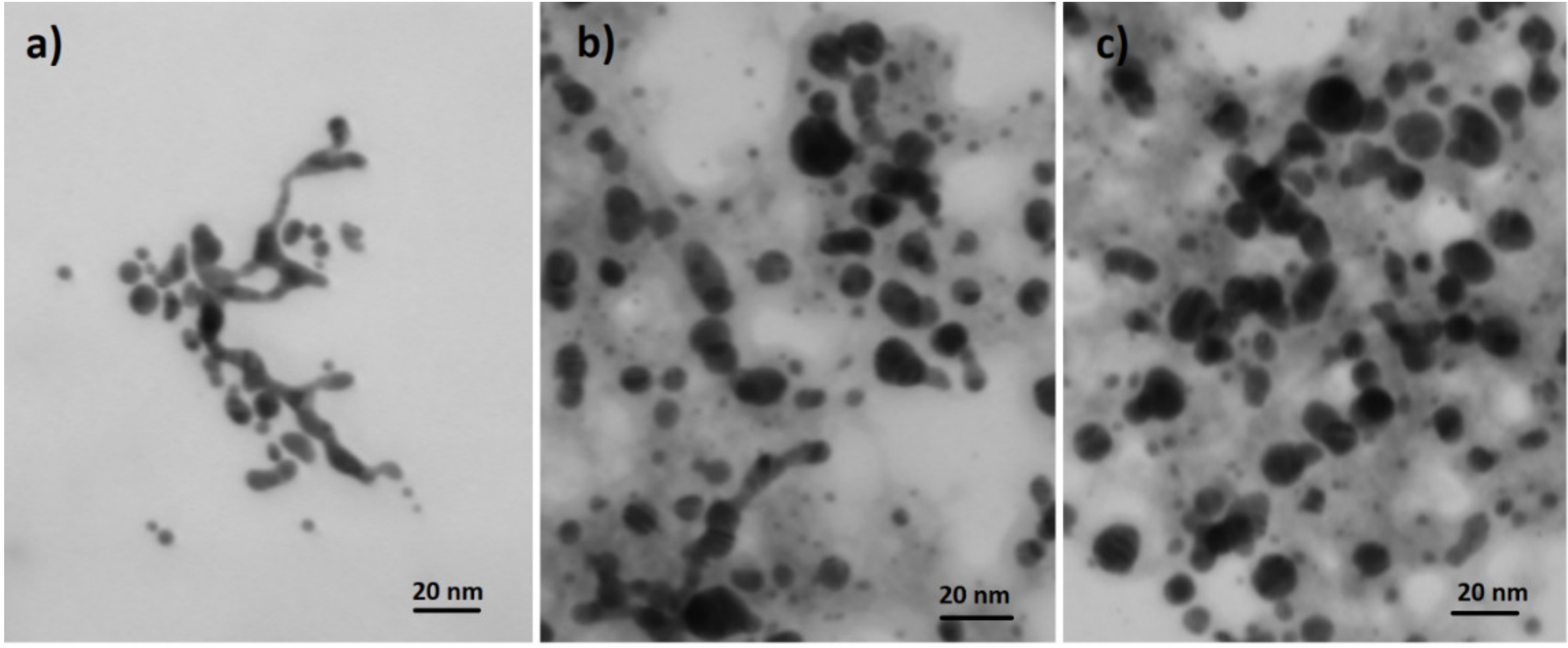
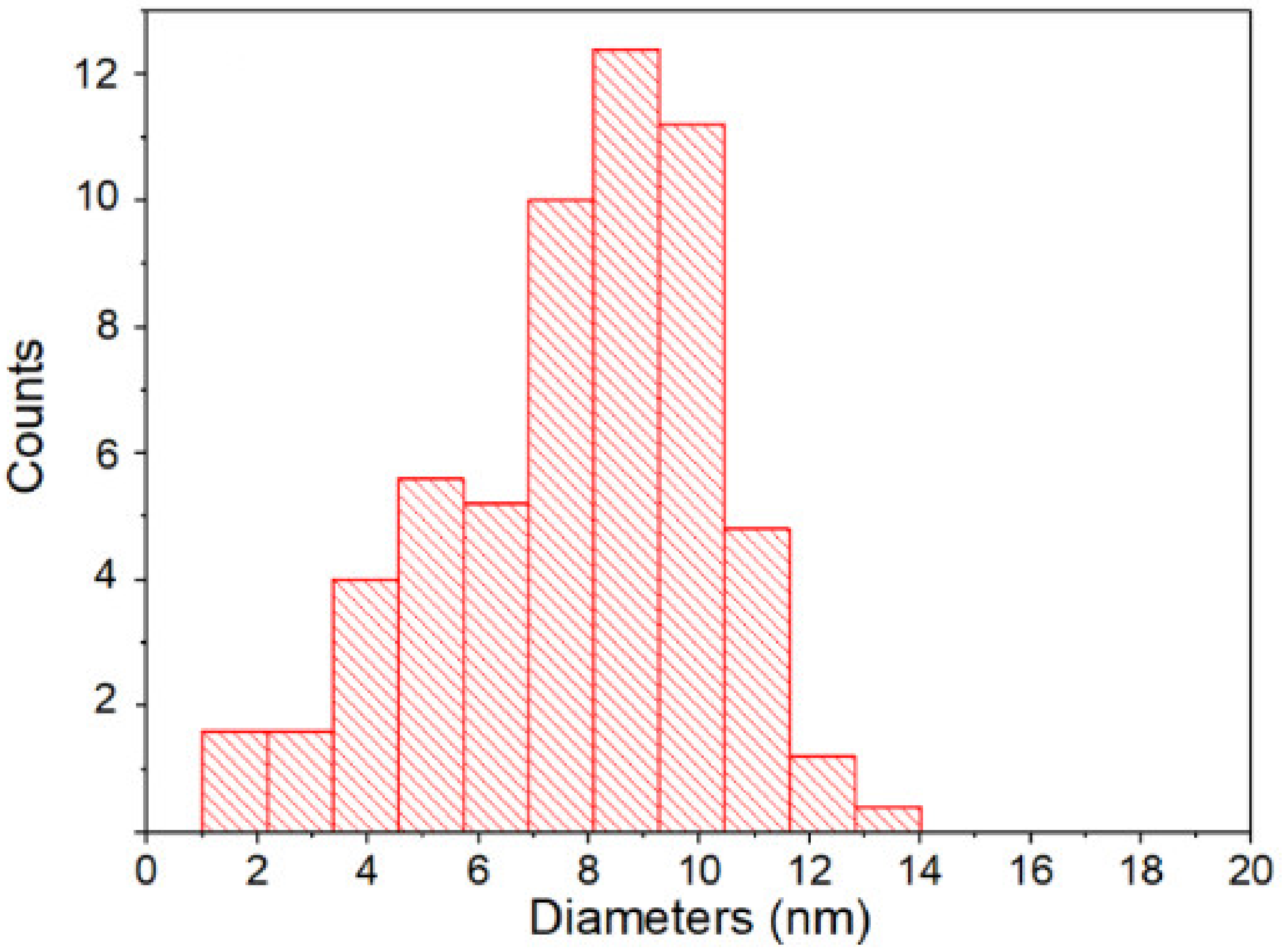
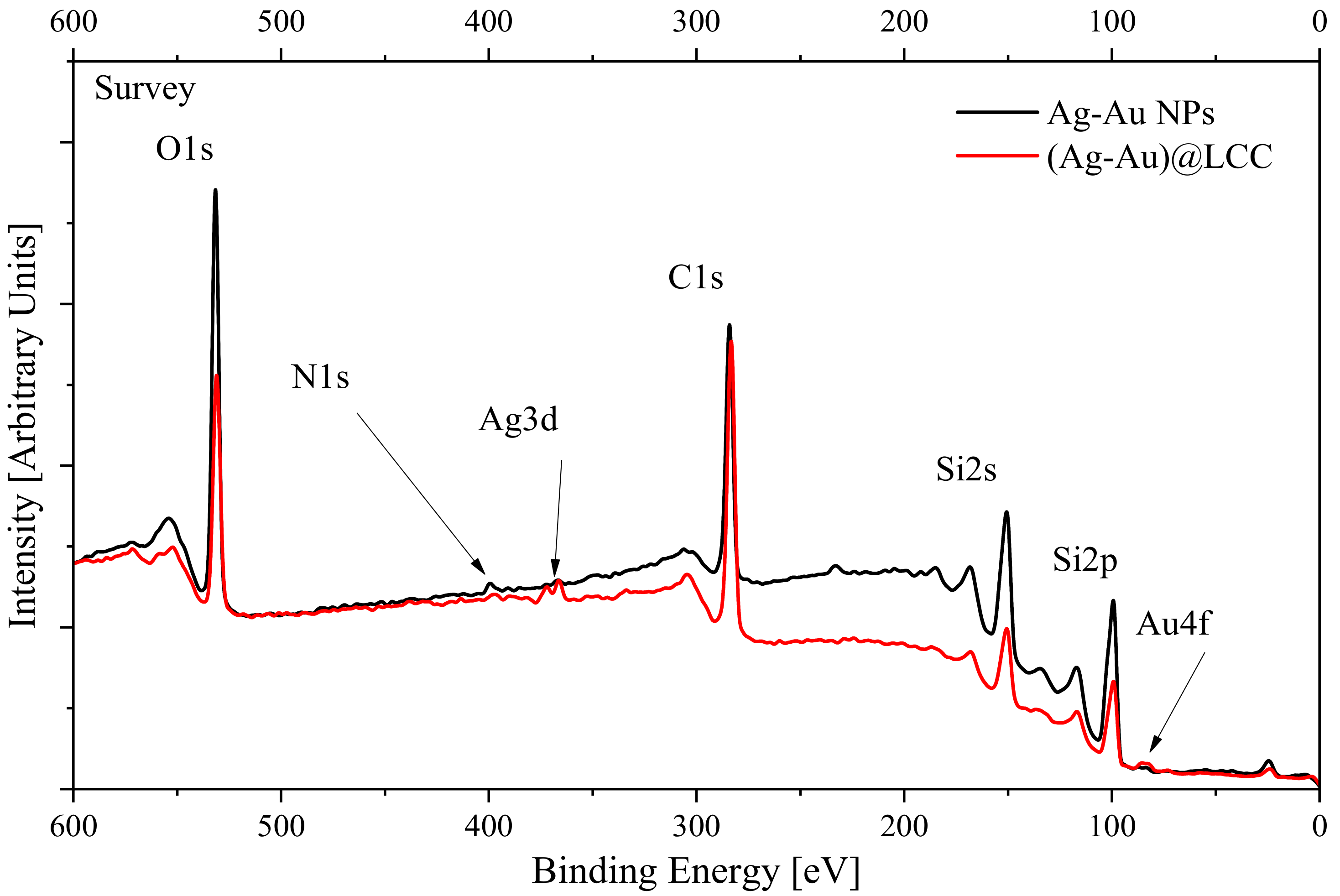
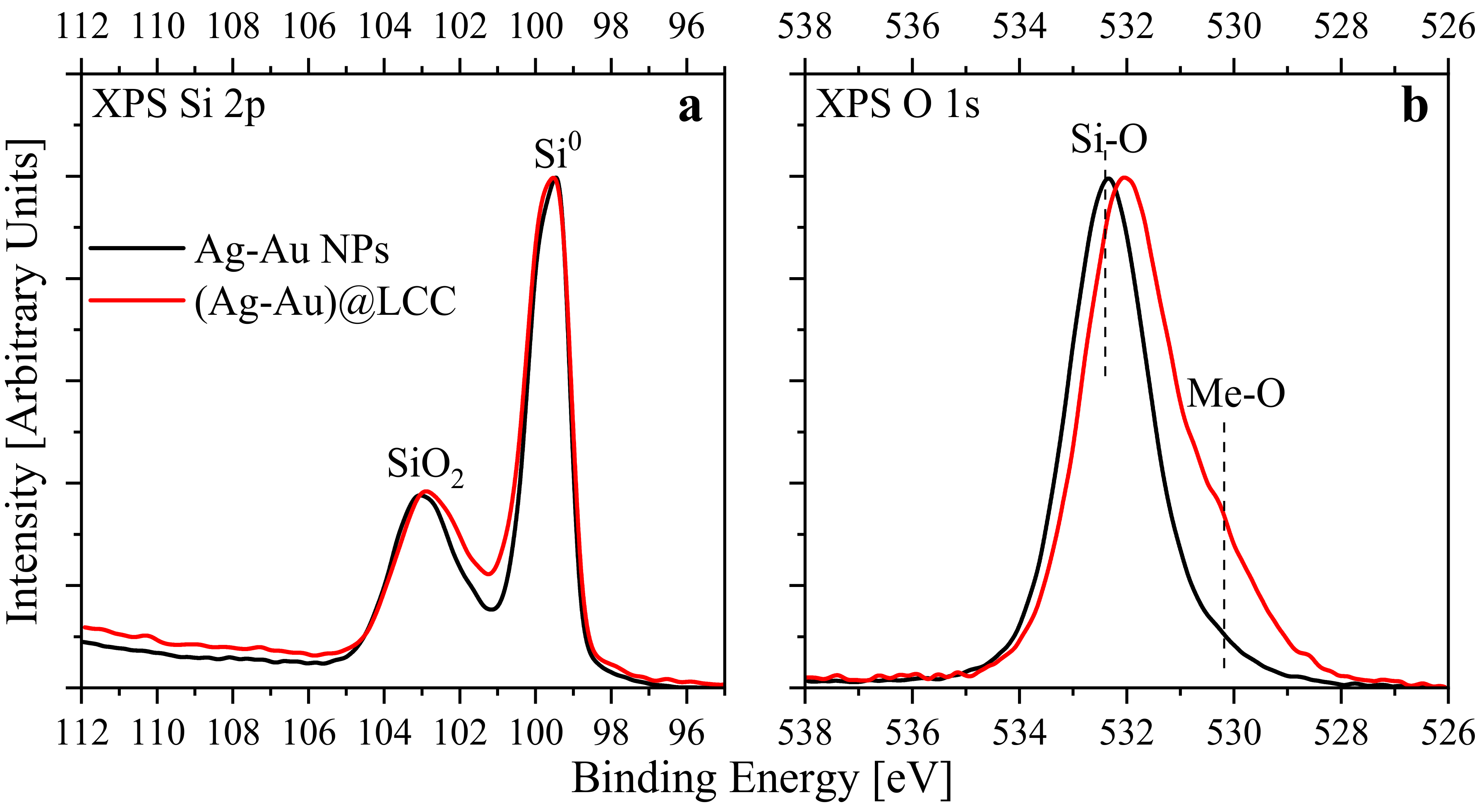

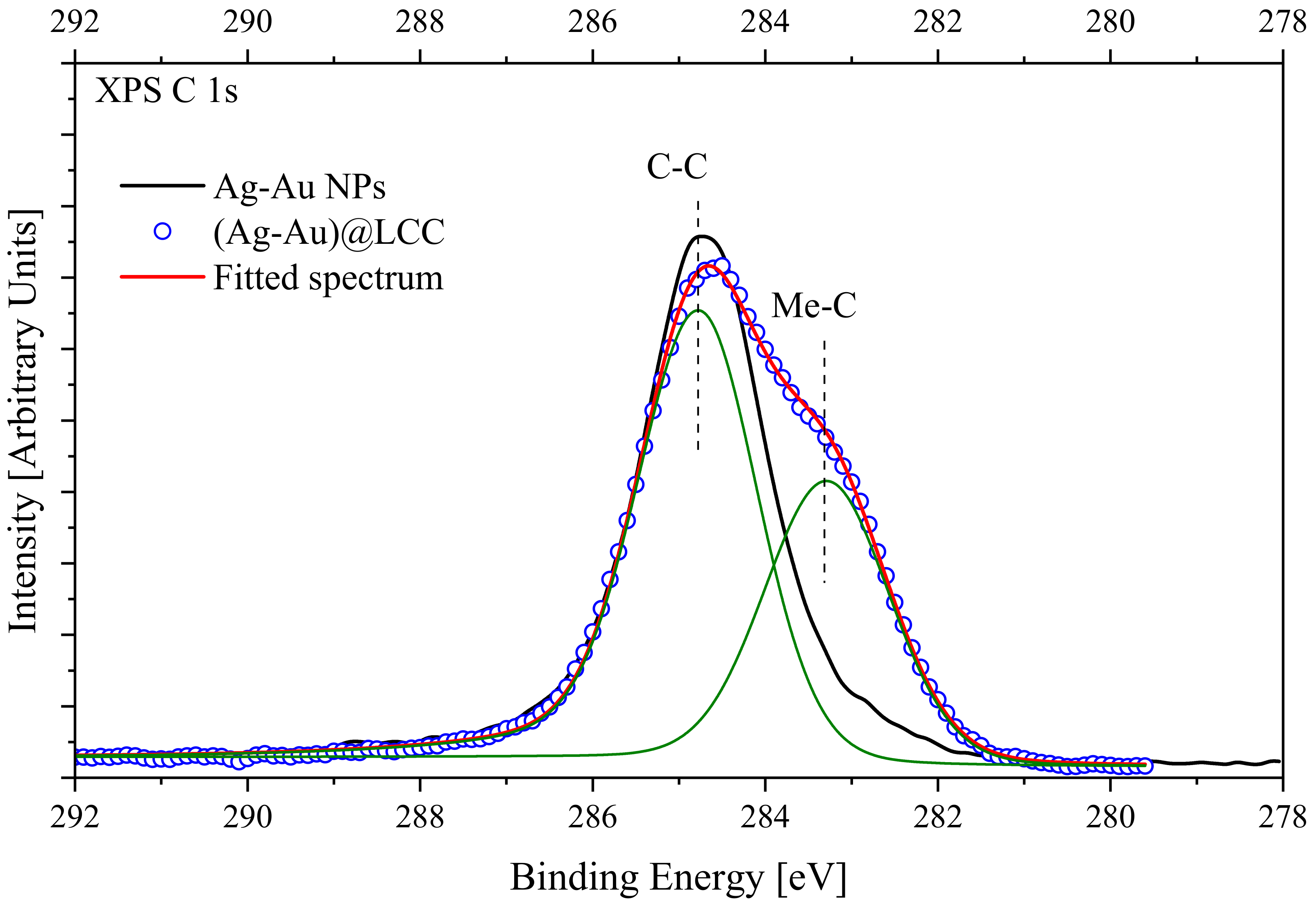
| Sample | C | O | Si | N | Ag | Au |
|---|---|---|---|---|---|---|
| (Ag-Au) NPs | 39 | 31 | 29.1 | 0.7 | 0.1 | 0.1 |
| (Ag-Au)@LCC | 61.8 | 20.3 | 16.6 | 0.8 | 0.4 | 0.1 |
Publisher’s Note: MDPI stays neutral with regard to jurisdictional claims in published maps and institutional affiliations. |
© 2021 by the authors. Licensee MDPI, Basel, Switzerland. This article is an open access article distributed under the terms and conditions of the Creative Commons Attribution (CC BY) license (http://creativecommons.org/licenses/by/4.0/).
Share and Cite
Zhidkov, I.S.; Kurmaev, E.Z.; Condorelli, M.; Cholakh, S.O.; Boyarchenkov, A.S.; Fazio, E.; D’Urso, L. X-ray Photoelectron Spectra of Ag-Au Colloidal Nanoparticles after Interaction with Linear Carbon Chains. Appl. Sci. 2021, 11, 685. https://doi.org/10.3390/app11020685
Zhidkov IS, Kurmaev EZ, Condorelli M, Cholakh SO, Boyarchenkov AS, Fazio E, D’Urso L. X-ray Photoelectron Spectra of Ag-Au Colloidal Nanoparticles after Interaction with Linear Carbon Chains. Applied Sciences. 2021; 11(2):685. https://doi.org/10.3390/app11020685
Chicago/Turabian StyleZhidkov, Ivan S., Ernst Z. Kurmaev, Marcello Condorelli, Seif O. Cholakh, Alexey S. Boyarchenkov, Enza Fazio, and Luisa D’Urso. 2021. "X-ray Photoelectron Spectra of Ag-Au Colloidal Nanoparticles after Interaction with Linear Carbon Chains" Applied Sciences 11, no. 2: 685. https://doi.org/10.3390/app11020685
APA StyleZhidkov, I. S., Kurmaev, E. Z., Condorelli, M., Cholakh, S. O., Boyarchenkov, A. S., Fazio, E., & D’Urso, L. (2021). X-ray Photoelectron Spectra of Ag-Au Colloidal Nanoparticles after Interaction with Linear Carbon Chains. Applied Sciences, 11(2), 685. https://doi.org/10.3390/app11020685








